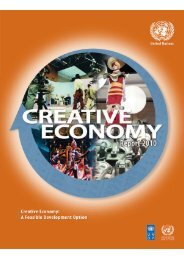Model curricula for journalism education for developing countries ...
Model curricula for journalism education for developing countries ...
Model curricula for journalism education for developing countries ...
Create successful ePaper yourself
Turn your PDF publications into a flip-book with our unique Google optimized e-Paper software.
43<br />
Thursday, and one weekend piece) and hand it in <strong>for</strong> recording each weekday<br />
morning. These pieces will give students practice in observation, narrative writing,<br />
and in recognizing story. By the end of the term they will have written about 75 short<br />
pieces (and three longer pieces). The aim is to make writing part of every student’s<br />
daily life. The obvious problem <strong>for</strong> the instructor is how to read all these pieces.<br />
Ideally, the instructor should be assisted by enough senior or graduate students (or<br />
local working journalists and writers) to read and critique at least one piece from<br />
every student each week. Failing these resources, the instructor should mark about<br />
15 students’ stories each day. Each student in a class of 150, that is to say, would<br />
have a piece marked every two weeks — seven pieces during the term. Students will<br />
receive credit, however, <strong>for</strong> every piece they submit.<br />
Students will also benefit from the weekly feedback of their peers in their small<br />
discussion groups. Again ideally, each group would be led by an upper-level or<br />
graduate student. If this is not possible, the instructor should rotate from group<br />
to group. Each group could choose one piece a week from each student, to be<br />
published in a weekly or monthly anthology, photocopied or online, or posted on a<br />
bulletin board or read on the school’s radio station. Midway through the term, and<br />
twice towards the end, students will write a longer piece employing techniques<br />
learned in lectures. In marking throughout the term, the instructor should try to<br />
focus on the good in students’ writing and resist responses that provoke fear and<br />
humiliation. Mistakes should not only be identified but also corrected. Students<br />
should be encouraged to experiment and discover their own voice, style, and<br />
creativity.<br />
Grammar: Each week, the instructor should assign a chapter of a grammar or style<br />
book, or give students a grammar handout, to be tested in a quiz the following week.<br />
If the instructor has assistance, the quizzes should be collected and marked and the<br />
marks recorded each week; if not, students should mark each other’s work in class<br />
and a grammar test should be set twice a term to be marked by the instructor. This<br />
syllabus will leave it to the instructor to select weekly grammar and style points to be<br />
studied and tested, since these are readily available in texts and vary from language<br />
to language. The purpose of every grammar lesson should be to improve writing. For<br />
example, tenses need to be mastered so that one can write consistently in a tense,<br />
correctly moving back to the past and <strong>for</strong>ward to the future as required. One should<br />
understand the difference between the active and passive voice so that one can use<br />
the active whenever possible. And so on.<br />
Number of hours per week: Two hours class time; plus 3 to 5 hours of<br />
out-of-class writing.

















